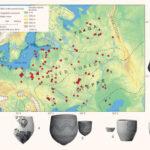A new image from the High Resolution Stereo Camera (HRSC) on board ESA’s Mars Express orbiter shows an exciting landscape of layered deposits, frost, ice, and dark dunes in Ultimi Scopuli, a region near the south pole of Mars.
This beautifully scene was captured by the High Resolution Stereo Camera on ESA’s Mars Express on May 19, 2022 during orbit 23219. Image credit: ESA / DLR / FU Berlin / CC BY-SA 3.0 IGO.
The amazing image, captured on May 19, 2022, shows a section of the landscape measuring approximately 65 by 215 km (40 by 134 miles) and located 14 degrees north of the Martian south pole.
The picture was acquired in the southern spring — the time when the ice retreats southward, leaving only a small ice cap at the south pole during summer in the southern hemisphere.
“During the seasonal cycle on Mars, carbon dioxide ice is deposited at the poles in winter,” said members of the Mars Express team.
“The amount of atmospheric gases trapped as ice at each pole in winter and then evaporating in spring is enormous, comprising over 10% of the atmosphere.”
“This process leads to strong pressure changes in the Martian gas envelope and, as a result, to very high wind speeds.”
“These occur primarily in the autumn and are caused by this difference in atmospheric pressure in the hemispheres.”
The two most eye-catching features in this image are two large impact craters connected by a striped band.
“The band and craters exhibit an intense reddish-brown hue that contrasts with the gray and white of the surrounding landscape,” the researchers said.
“In addition, alternating layers can be seen in the crater rims and band — especially when you zoom in.”
“These layers are successive layers of dust and sand that have been deposited continuously and approximately horizontally on the terrain features.”
“They consist primarily of water ice and approximately 10% of fine sediments.”
“The individual layers differ from each other in their albedo, their color, thickness and their degree of weathering.”
“These deposits are formed by dust and water ice dissolving from the atmosphere and sinking to the surface, and by direct frost condensation on the ground.”
“The orange regions in the image clearly show the layered nature of these deposits.”
“Some regions in the image appear hazy. Clouds have formed over the scene and can be detected, particularly in the center, above the band,” they added.
“Clouds in the south polar region contain not only water droplets frozen into ice crystals, but often needles of carbon dioxide ice given the extremely low temperatures of well below minus 100 degrees Celsius (minus 148 degrees Fahrenheit).”
“Their trajectory as they sink to the ground is partly influenced by the landforms on the surface.”
“In some regions of the image, extensive evaporation structures can be seen, making the surface appear leveled and resembling the water level of terrestrial lakes.”
“Dark dunes and dune fields can be identified in numerous places, often covered by a thin layer of frost,” the scientists said.
“Where they have been strung into thin lines by the wind, they resemble a formation of elongated rock ridges and wind alleys pointing in the same direction, known as yardangs.”
“From their orientation one can read the prevailing wind direction, which can vary greatly on a local scale and is strongly influenced by the terrain formations.”
In addition, the image shows individual, small dark spots from which narrow lines that resemble spider legs emerge in different directions.
“These may be indicative of another distribution process of dark material typical of polar latitudes on Mars: carbon dioxide jets formed by heating dark material under an ice sheet, leading to a direct transition of ice from the solid to the gaseous state, which is then ejected at high pressure in fountains mixed with dark sand,” the researchers said.
“Continuous observation of these phenomena help us to understand processes that are constantly changing the surface appearance in the polar regions on Mars.”




